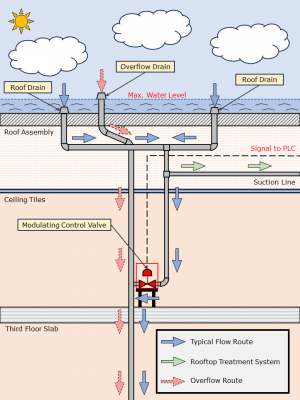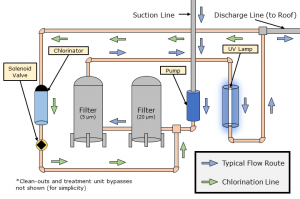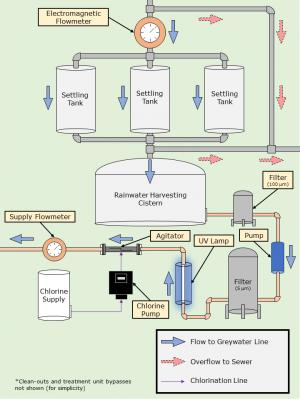Smart Blue Roof - Project Overview (Summary)
The sections below are intended to mirror the information provided in the Smart Blue Roof Tour hosted at CVC’s Head Office or serve as a review of the material presented during the tour.
Click here for a more detailed overview.
Introduction[edit]
Conventional flat roofs on industrial, commercial, and institutional buildings are designed to quickly remove rainwater from their surfaces. The passive control strategy of these conventional roof assemblies provides no opportunity for rainwater reuse and contributes to downstream erosion and the potential for flooding. Credit Valley Conservation’s Smart Blue Roof (SBR) flips this idea on its head and uses an active control strategy to capture rainwater for reuse. This emerging technology has the capacity to effectively manage runoff, capture rainwater for non-potable reuse, and conserve energy through evaporative cooling. Here are some fun facts about the SBR:
- CVC’s SBR is the first blue roof system to be compliant with the Canadian Standards Association’s new Rainwater Harvesting Standard (CSA B805-18).
- The SBR is large enough to capture the 100-year design storm (the largest storm predicted to occur in a 100-year time period) within its footprint.
Station 1 – Roof Surface[edit]
By utilizing the roof of Building A for storage, CVC’s head office gains the ability to capture an additional 40,000 L of rainwater. Some of the key features of the SBR surface include:
- Water can be ponded at an average depth of 130 mm, which equates to a depth of 75 mm at the parapet (roof edge) and 250 mm at the roof drains (lowest point).
- Water can be stored on the roof for up to six (6) days.
- The roof assembly includes a polymethyl methacrylate (PMMA) membrane, which is applied like paint and has no seams.
- The roof assembly is equipped with an electric field vector mapping (EFVM®) leak detection system that can locate leaks with “pin-point” accuracy.
Station 2 – Modulating Control Valves[edit]
The key mechanisms for the SBR’s ability to hold water are the modulating control valves installed on the third floor. The SBR roof drains are configured with valves that stop drainage from occurring.
Station 3 – Third-Floor Treatment System[edit]
The City of Mississauga required that CVC install a separate CSA-compliant water recirculation system on the third floor. This system draws rooftop rainwater through the recirculation line that is immediately upstream of the east modulating control valve. The following are the main treatment components found on the third floor:
- Micron Filters: Filtration is important for removing impurities, eliminating odours, and ensuring debris does not impede the efficacy of the ultra-violet treatment (UV) unit by blocking light.
- UV Lamp: Disinfects rainwater by sterilizing bacteria and viruses with UV radiation. Note that UV disinfection does not have any residual effect that can be harmful to humans or aquatic life.
- Chlorine Pump: Provides a chlorine residual of 0.5 mg/L that can ensure that rainwater on the roof surface is protected from recontamination.
- Solenoid Valve: Determines when chlorination is allowed to occur by opening when the rooftop chlorine residual is too low.
Station 4 – Basement Cistern and Treatment System[edit]
When rainwater is drained from the roof surface into the basement, it is collected by a rainwater cistern (CVC’s old, passive system). Water from this cistern can be pumped through the SBR’s second CSA-compliant treatment system. The following are the main treatment components of this basement system:
- Settling Tanks: Allow any sediment that is suspended in the rainwater to settle.
- Rainwater Cistern: Holds water before it is pumped through the treatment system.
- Micron Filter: Removes impurities, eliminates odours, and ensures debris does not impeded the efficacy of the UV treatment unit by blocking light.
- UV Lamp: Disinfects rainwater by sterilizing bacteria and viruses with UV radiation. Note that UV disinfection does not have any residual effect that can be harmful to humans or aquatic life.
- Chlorine Pump: Provides a chlorine residual of 0.5 mg/L that can ensure that rainwater is protected from recontamination in the distribution line or when supplied to the toilets.
- Agitator: Mixes the newly introduced chlorine solution into the treated rainwater.
Station 5 – Programmable Logic Controller[edit]
The SBR is an active stormwater control because it utilizes control logic to make decisions on how captured rainwater is best utilized. The SBR is equipped with a series of sensors and a central programmable logic controller (PLC). The PLC is fed information from the sensors that is used by the PLC to decide how the system should be manipulated to maximize the benefits of the SBR. Here are some of the key sensors that are part of the SBR’s operation:
- Electromagnetic Flowmeter: Measures amount of rainwater that is conveyed into the basement. This measures how much water is being drained from the SBR and how much water is harvested OR overflows into the storm sewer (if the cistern overflows).
- Greywater Flowmeter: Measures the amount of treated water that is introduced into the greywater line.
- Rooftop Level Sensor: Measures elevation of rainwater on the roof. This is useful for determining if there is enough water on the roof to fill up the basement cistern without jeopardizing the ability of the third-floor treatment system to recirculate water.
- Cistern Level Sensor: Measures elevation of rainwater in the cistern. This is useful for determining if the cistern needs to be replenished.
- Rooftop temperature Sensors: Measures the temperatures above the building and on the inside of the roof assembly (below the concrete roof slab). These sensors compare the heat gradient across the roof assembly where the SBR is located and where a conventional roof system remains. By doing so, the cooling benefit and energy savings of the SBR can be calculated.


